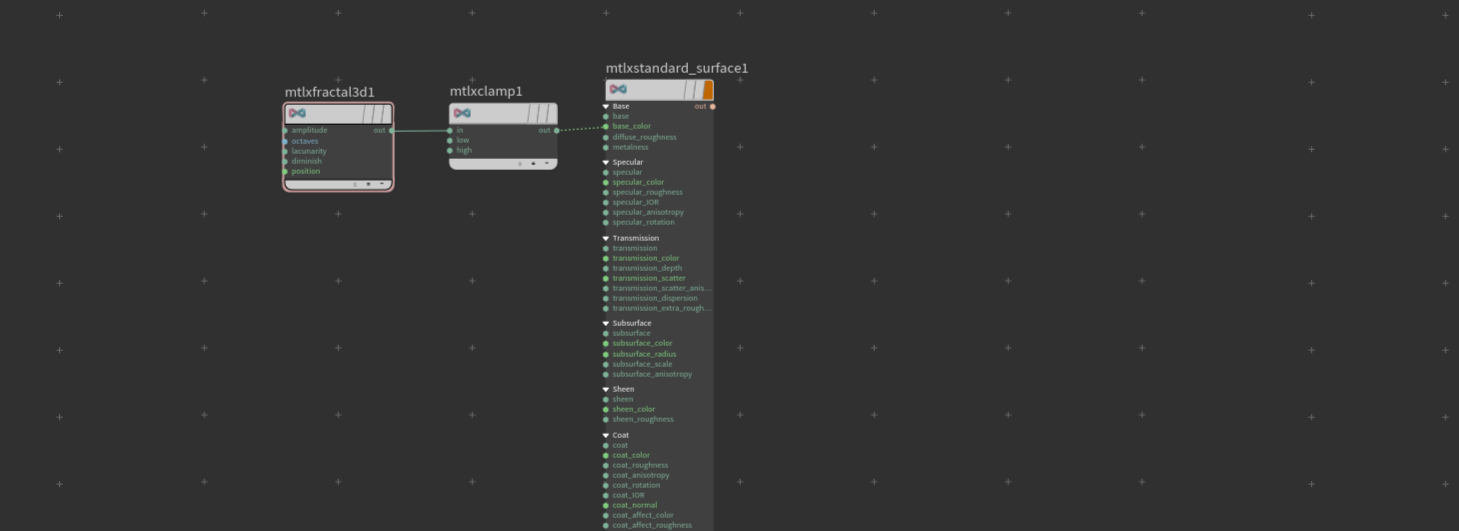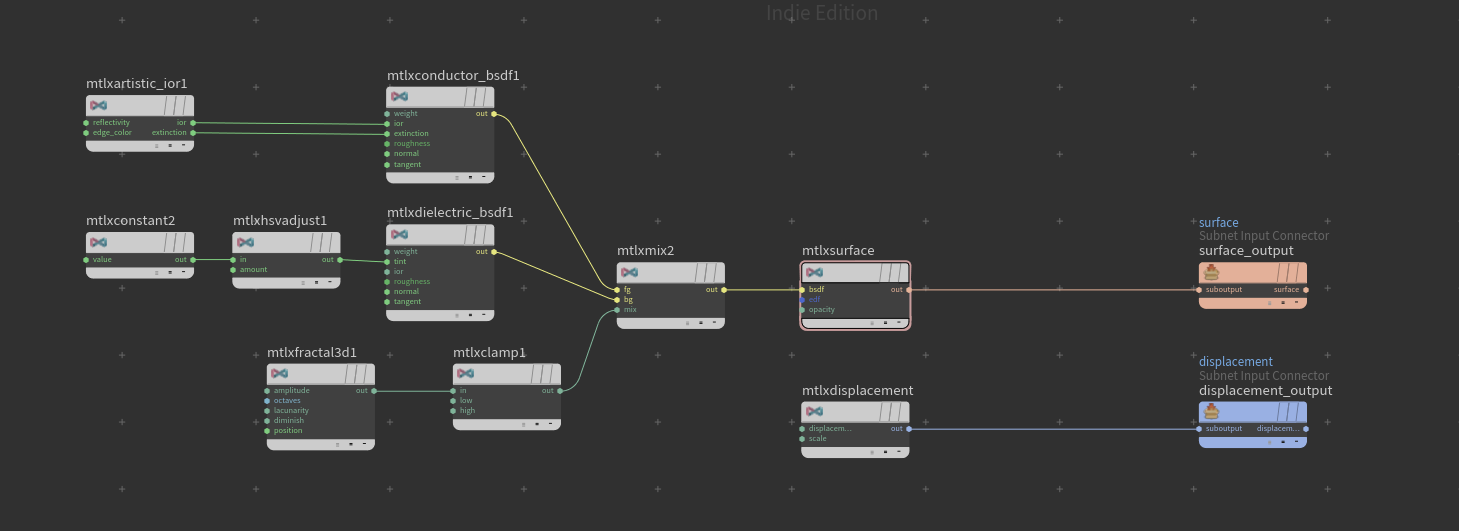Pxlink: DTA Camera / Algebra / Rendering / Mat Data
Obsidian: [[DTA]] [[16-02-01-Rendering|Rendering]] / [[08-01-01-Material|matdata]] / [[16-02-01-Substance_Designer|substancedesigner]] / [[09-01-01-U_Optimisation|uoptimization]] [[17-01-01-Modeling]] [[17-01-01-Modeling_Foliage]] [[09-01-01-U_Shaders]]
External links: Cg encyclopedia SeblaGarde blog PBR Iri Shinsoj Substance PBR guide PBR wiki 2018
YT
Shaders
Fragment shader
Shader Language has a single main function that returns a color at the end. Each thread is not just blind but also memoryless.
VS Vertex shader
.
PS Pixel shader (old fragment)
grid of pixels that work paralel
Compute shader
in paralel on gpu subdivisions workgroups and in each group divisions
Mesh shader
Mesh Shaders
- for new tessalation
Task shader
call based of cam frustrum
PBR
Energy conservation Eyes are less sensitive in dark.
Workflow
Metal / Roughness
A byproduct of using the metal/roughness workflow is that it can produce a white edge artifact, (Unreal)
- white artefacts on blend
Specular/glossiness
- dark artefacts on blend
MaterialX
Layers Horizontal and vertical:
@Cd » W USD: displayColor
MAT: 1) Mat lib
- matx subnet. » mtlx standard
- BEFORE PLUGIN BASE COLOR: convert jpg to aces ACES: karma_OCIO_transform Utility - Linear - sRGB » ACES - ACEScg
- BEFORE PLUGIN NORMAL:
-
mtlxgeometrycolor - vertex color // or geompropvalue z parametrem displayColor (Cd in sops)
| Transparency | Specular reflection (coating) |
| Emission Additive | Specular reflection |
| Specular reflection (metal) | Specular reflection |
| Specular transmision | Specular retro-reflection (sheen) |
Workflow
Material Standard

Mat Nodes
Base nodes
mtlx Material Standard Surface- use like default materialcollect node- pipe at the end and check orange flag as output for color input to base_color
Surface packed

surface/volume/light/displace
BRDF Nodes
Oren-Nayar- diffuse_brdfDisney Principled BRDF- burley_diffuse_brdfConductor BRDF- artistic friendly Metalic fresnel (energy compensation for multiple microfacet bounces)- D = ddx/beckman
- G = height corelated smith
- F = conductor
Dielectric- D = ddx/beckman
- G = height corelated smith
- F = dielectric / schlick
Generalized SchlickThin Filmsheen- cloths
Features
Displacement:
Collectnode - can plug in mtlx in mtlxImage> mtlxRemapColor FA > mtlxDisplacement
Basic
Usd Prim Var Reader- bind attribs / get attrib
Math
- mtlx
Constant- value - mtlx
Multiply - mtlx
Remap- - mtlx
Mix- lerp - mtlx
Ramp- Slower mix in vex
Noise
- mtlx
Fractal 3d- noise - mtlx
cellnoise 3d - mtlx
noise 3d - mtlx
worley noise 3d
Texture
- mtlx
Image/ mtlxTiled Image- Load texture basic - mtlx
UsdUVTexture- Load texture - channel options
How to Add normal map:
- mtlx
Image>Normal Map- Load nm texture
UV
- mtlx
Texture coordinates- - mtlx
Triplanar Projection…
Volume:
- mtlx
Volumevdf- volume > mtlxanisotropic vdfset absorption&scattering > mtlxGeompropvaluegeomprop: density > set valueedfemmition
non mtlx Nodes
- Curvature
- Range
- Color correct
- Ambient occlusion
- State vector
Unrela
Options
| Blend models | | Usage | | —- | —- | —- | | | | | LEGACY :
| LEGACY: | Ps/Vs | Cost | Usage |
|---|---|---|---|
| Sss | |||
| Preintegrated Skin | cheaper to render than the Sss method | ||
| Subsurface Profile | higher-end skin rendering | ||
| 2 Sided Foliage | simulate transmision, for cloths (non solid materials) | ||
| Hair | multiple specular highlights: 1) color of light, 2) mix of hair and light color. | ||
| Cloth | “fuzz” layer | ||
| Single Layer Water | translucent in opaque mode | ||
| Thin Translucent | colored glass (background) white specular highlight and the tinted background are needed |
| Translucency Mode | Ps/Vs | Cost | Usage |
|---|---|---|---|
| Volume Non Directional | pixel | cheapest pixel | |
| Volume Directional | pixel | ||
| Volume Per-Vertex Non Directional | vert | cheapest vert | |
| Volume Per-Vertex Directional | vert | ||
| Surface Translucency Volume | low per pixel but blurry | glass, water | |
| Surface forward Shading | forward | most expensive. Each light per pixel | glass, water |
Thin Transparent shading model and material expression, you are able to accurately represent tinted and colored transparent material
Decals
There are 11 blend modes that decals can use:
DBuffer decals.
You can access this buffer in other materials.
- set decal response in material. (what is not set need to be blended with DBuffer texture inside of material)
The DBuffer decals can be used with lighting. These are not on by default and must be enabled in the Project Settings > Rendering section.
| Translucent | Can use Diffuse, Metallic, Specular, Roughness, Emissive, Opacity, and Normal |
| Stain | Is a modulate type blend with Diffuse and Opacity. |
| Normal | Uses the Opacity and Normal channels and only affects the Normal map layer it is projecting on. |
| Emissive | Uses Emissive and Opacity only. |
| Volumetric Distance Function | Use the output of signed distance in Opacity depending on Light Vector. |
| DBuffer Translucent Color, Normal, Roughness | This is non-metallic and will use the Color, Opacity, Roughness, and Normal to work with baked lighting. |
| DBuffer Translucent Color | This is non-metallic and will use only the Color and Opacity to work with baked lighting. |
| DBuffer Translucent Color, Normal | This is non-metallic and will use the Color and Normal to work with baked lighting. |
| DBuffer Translucent Color, Roughness | This is non-metallic and will use the Color and Roughness to work with baked lighting. |
| DBuffer Translucent Normal | This will only use the Opacity and Normal channels to work with baked lighting. |
| DBuffer Translucent Normal, Roughness | This will only use the Roughness, Opacity, and Normal to work with baked lighting. |
| DBuffer Translucent Roughness | This will only use the Roughness and Opacity to work with baked lighting. |
Unreal material nodes
Camera vector is a vector, that points from pixel to camera position. (observatiion vector)
CameraDirectionVector, is a vector, that corresponds to direction, where camera is pointing in worldspace.
Strata
Specular workflow BSDF layering is expensive
https://youtu.be/rIktWZ-lpWw
Blend Materials
Add - not physically correct
Horizontal layers blend materials
- background / foreground
Vertical layers- one on top of other and define what thick first layer is. Expensive - top / bottom with thickness
Coverage weight(how strong material is)
Slab « is a material
Substrate Slab BSDF:
BSDF - Bidirectional scattering distribution functions
F0 v3 - Reflection at facing angle - can use to color highlights (Reflective indexes )
F90 - Reflection at side of object.
Anisotropy - stretching highlight
SSS MFP - Subsurface mean free path (Opacity)- densityof material and effect of absorption (in cm)
SSS MFP Scale -
SSS Phase Anisotropy - Negative values negative scattering, 0 - scatter in both dir
Second roughness - Second roughness weight on 0 is using only first and 1 will use only second.
Fuzz Roughness s - Emulate fuzz
Metal
SMF Metal - node help to convert metallic workflow but can be achieved by Diffuse Albedo and F0
- Diffuse - diffuse is separated so 0,0,0
- F0 - should be color of metal
Silk fabric
Thin-film
- f0 & f90
- dif - 0
Triplanar
Basic Biplanar dithered and optimized
Features
Motion Vectors
https://www.sidefx.com/tutorials/create-motion-vectors-for-time-warping-image-sequences/
6D Lightmaps.
Biplanar projection:
https://www.shadertoy.com/view/ws3Bzf
https://iquilezles.org/www/articles/biplanar/biplanar.htm
IOR: most dielectrics 1.5.
Unreal simplified disney model
Dense details Landscape
- Paralax / wpo /
- Tessal / vs
- Virtual texture - runtime Vertual Texture https://youtu.be/kxsQ5m2IAXs